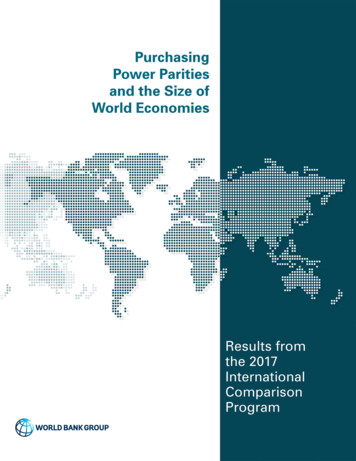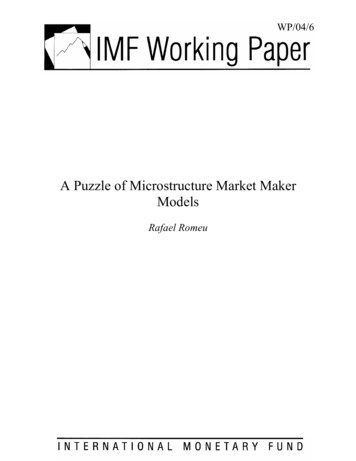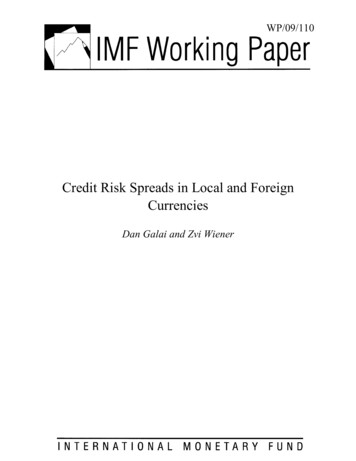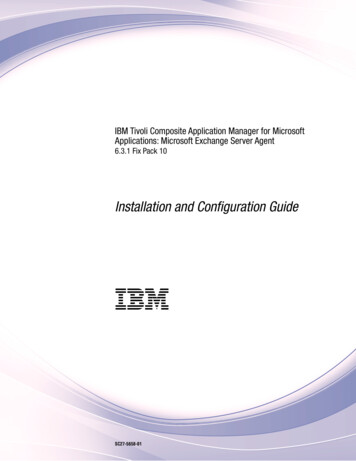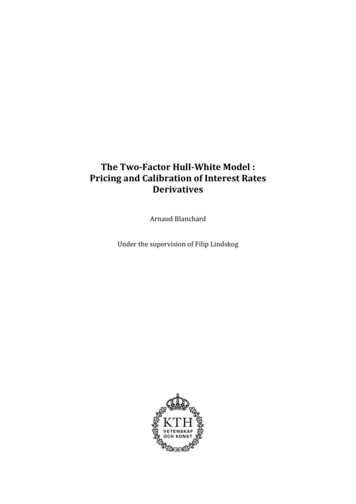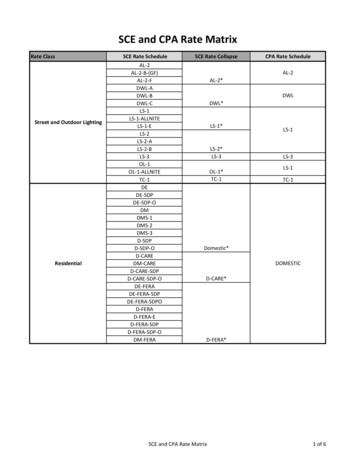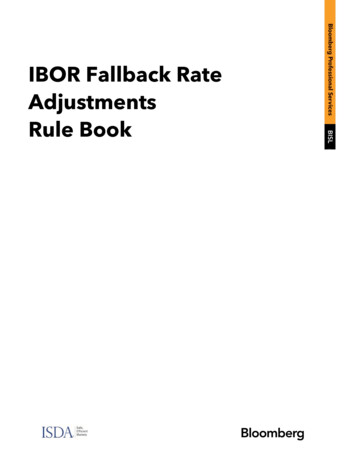
Transcription
Munich Personal RePEc ArchiveInternational Parities and Exchange RateDeterminationZhao, Yan31 March 2005Online at https://mpra.ub.uni-muenchen.de/36967/MPRA Paper No. 36967, posted 27 Feb 2012 09:53 UTC
International ParitiesandExchange Rate DeterminationYan Zhao*AbstractThe model of equilibrium exchange rate combining purchasing power parity (PPP)and uncovered interest parity (UIP) is widely tested using the cointegration approach.Most of the recent studies, however, are deficient in the treatment of expectations andthe power of tests.This paper aims at resolving the two deficiencies by deriving and testing theyen/dollar exchange rate model.Perfect foresight is assumed to circumvent theexpectation problem and a modification of cointegration variables is introduced toimprove the power of tests.With this new methodology, supportive evidence for the hypothesis of combiningPPP and UIP is found in the short run: cointegration between the future exchange rate,price and interest rate differentials exists; the error correction model (ECM) issignificant.The paper also suggests that it is the interest rate differential, ratherthan the price differential, that explains more of the movement of the nominalexchange rate in the short run.In the long run, however, the cointegration does notexist because the interest rate differential becomes exogenous.*Graduate student in the Master course at the Otaru University of Commerce, Japan.E-mail: g200304@edu-otaru.uc.ac.jp.
AcknowledgementsThis paper is written under the supervision of Professor HiroshiShibuya at the Otaru University of Commerce.I still remember the dayswhen he held two seminars per week for me last year: InternationalFinance and Time-Series Econometrics, without which I could not havebegun this research. I think he is a great instructor in keeping the balancebetween intriguing the student’s interest and teaching hard materials.Hisinstruction is highly appreciated.Moreover, Professor Shibuya made many important suggestions andremarks on this paper.It was my first time to write a research paper andduring the writing process, what he gave me was hints rather thaninstructions.He never told me what I should do or should not do.he gave me full latitude to try my own idea.Instead,I realize now that working outone’s own idea is really important to do research. It is the combination ofhis supervision and my own work that produced this paper.Special thanks should also be given to Professor Ryosuke Wada, whotaught me Finance and offered DataStream support for this paper.Sincethis paper is also the result of my graduate studies, I would like to thankthe following professors: Akihiko Kawaura, Kenji Yamamoto, ShigeruNishiyama and Tomoichi Shinotsuka.
Contents1.2.Introduction. 11.1.PPP as the First Exchange Rate Model . 11.2.Combining PPP with UIP (CHEER) . 21.3.Two Problems of the CHEER Approach. 31.4.Solution of the Two Problems. 5Literature Survey. 72.12.22.33.Review of PPP . 72.1.1.What’s PPP?. 72.1.2.Empirical tests of PPP. 8Review of UIP. 122.2.1.What’s UIP? . 122.2.2.Empirical test of UIP. 13Cointegration Analysis of PPP and UIP . 15Short-Run Analysis (Jan. 1973 Jun. 2004) . 183.1.3.2.3.3.Pretests of PPP and UIP . 183.1.1.Unit root process and Dickey-Fuller test. 183.1.2.Nonstationary process and PPP test . 193.1.3.Stationary process and UIP test. 24The Model of Exchange Rate Determination. 263.2.1.Is the relative price enough to determine the exchange rate?. 263.2.2.The model of exchange rate determination . 28Econometric Analysis . 293.3.1.Cointegration analysis. 293.3.2.The effect of the modification and the increased test power. 313.3.3.The error correction model (ECM) . 333.3.4.Causality test and innovation accounting. 34i
4.Long-Run Analysis (Year 1870 2003) . 414.1.5.The CHEER Model of Exchange Rate Determination. 414.1.1.Unit root tests . 414.1.2.The nominal exchange rate determination model . 454.2.Engle-Granger Cointegration Test and ECM . 464.3.Granger Causality and Johansen Methodology. 48Conclusion . 53Appendix. 56Appendix 1: Program Description . 56Appendix 2: Data Source and Description. 57Appendix 3: Data Summary. 58Appendix 4: Short-Run Forecast Error . 59Appendix 5: Long-Run Forecast Error Decomposition . 61References. 62ii
1. IntroductionRecently the question of exchange rate determination has been extensivelyresearched.Knowing the level of equilibrium exchange rate is becoming animportant issue in the field of international finance and macroeconomics,especially with the more integrated world economy.It is of vital importance notonly for individuals and firms engaging in international trade and finance, butalso for the monetary authorities conducting monetary policy.Moreover, theequilibrium exchange rate is an important macroeconomic policy variable for bothdeveloping and developed countries.As a result, almost all open macroeconomictheories involve the measurement of equilibrium exchange rate.1.1. PPP as the First Exchange Rate ModelIn the economic literature, purchasing power parity (PPP), which was putforth by Cassel (1921)1, is the first theory to measure the equilibrium exchangerate level.Based on the law of one price (LOP), purchasing power parity statesthat the relative price determines the exchange rate movement.According to the PPP hypothesis, the relative price is the main determinant ofthe exchange rate and if written in log forms, the exchange rate should be equalto the price differential.The common deviation of the exchange rate from therelative price and the more volatile exchange rate fluctuation in the post-floatingperiod, however, prompted many economists to test the validity of purchasing1Gustav Cassel 1921. The World’s Monetary Problems. London: Constable.1
power parity 2 .Recent tests of PPP have been typically based on theinvestigation of the time series property of the real exchange rate, which can beseen as the residuals from PPP.These test results3 indicate that PPP may nothold: the real exchange rates are not always stationary.the short run is common.The failure of PPP inEven in the long run, the validity of PPP is mixed.1.2. Combining PPP with UIP (CHEER)The failure of PPP caused many people to raise doubt on the PPP as the modelof equilibrium exchange rate.With the great expansion of world financialmarkets in the past twenty years, some economists put forward a model ofequilibrium exchange rate that combines the purchasing power parity anduncovered interest parity (UIP).UIP is derived on the assumption of foreignexchange market efficiency, i.e., there is no “excessive arbitrage opportunity”.UIP states the relationship between the exchange rate and the interest ratedifferential, indicating that an increasing domestic to foreign interest ratedifferential will generate expected depreciation of the exchange rate.The proponents of the model that combines PPP and UIP argue that PPPrepresents the equilibrium of goods market only. They suggest that the pricelevels are not sufficient to capture all the factors causing fluctuations of theexchange rate without taking the world financial markets into account.According to their arguments, the exchange rate deviation from PPP is not2Engel and Morley (2001) proposed a different view and they developed a model to showthat the nominal exchange rate converges much more slowly than the prices.3See Chapter 2 of this paper for more details of the literature survey of PPP.2
surprising because of the existence of non-zero interest rate differentials.The model that combines PPP and UIP reflects the idea that although PPPserves as an important measurement of the exchange rate movements, itspredictive power can be enhanced by allowing for the effects of financial marketswhen calculating the equilibrium exchange rate level.This methodology,therefore, is called as the capital enhanced equilibrium exchange rate (CHEER)approach by MacDonald (2000).We adopt this terminology hereto in this paper.The CHEER approach was first proposed by Juselius (1991) and thendeveloped by Johansen and Juselius (1992).Since then, the CHEER approachhas become popular among economists in the field of exchange rate determination(See Chapter 2 for literature survey).1.3. Two Problems of the CHEER ApproachAlmost all papers on the CHEER approach try to find supporting evidence bysearching for cointegration relationship among exchange rate, price and interestrate differentials.Those papers, however, have two major problems.The first problem is an inappropriate treatment of expectation in thecointegration model.The cointegration relationship is often investigatedbetween prices, interest rates and the contemporaneous, not the expected futureexchange rate. Since UIP states the relationship between interest rates andexpected future exchange rate, their cointegration models are not consistent withthe UIP hypothesis.Therefore, their models do not combine PPP and UIPtheories correctly.3
The second problem is that their studies lack the power of rejecting the nullhypothesis of no cointegration, casting doubt on the validity of CHEERhypothesis.Careful reading of those papers 4 reveals that the failure ofcointegration often occurs in short data span while cointegration often becomesapparent in the longer data span.The contingent property on data span has thesame similarity as PPP and UIP, which are also believed to be long-runphenomenon 5 .Is it possible that the failure of PPP or UIP causes thenon-rejection of no cointegration6?This paper shows that either a failure of PPP or UIP does result innon-rejection of no-cointegration.The reason is that the linear sum of errorterms in PPP and UIP will not be stationary if exactly one of them fails to hold7.In this case, it is impossible to find evidence supporting the CHEER approachsince the null of no cointegration cannot be rejected.If either PPP or UIP fails tohold, the variables in the cointegration analysis need to be modified to increasethe possibility of finding cointegration.Thus, an appropriate step in theinvestigation of whether PPP and UIP hold is essential to improve the power ofcointegration analysis.Since PPP and UIP are rather long-run than short-runphenomenon, we expect that it is necessary to distinguish the CHEER modelsaccording to the data span.4See Section 2.3 of this paper.Most people believe PPP is a long-run phenomenon because price adjustment takes time.The conclusion about whether UIP is also a long-run phenomenon is not necessarily widelyaccepted, although some people find that UIP tends to hold better with longer data span.6This sentence contains two “no” and looks awkward. It is technically accurate, however,since the null hypothesis of no cointegration is always tested in the CHEER approach. If thenull hypothesis is rejected, we find supporting evidence of CHEER approach and vice versa.7Either PPP or UIP fails, not both of them. The linear combination of the PPP and UIPerrors can be cointegrated if both of them are nonstationary.54
1.4. Solution of the Two ProblemsThis paper aims at solving the above two problems in the CHEER approach.The first problem of expectation is circumvented in a straightforward way byintroducing expectation in terms of perfect insight.The future nominalexchange rate is thus taken as the substitute for the expected future exchangerate.Expectation is necessary to represent UIP correctly and in some CHEERpaper, an expectation is formed on the price differentials (See Stephens, 2004, forexample.). In reality, however, people do not always focus on goods marketsbecause price level changes in all items are not easy to observe. It is quitepossible for them to expect future exchange rate changes from financial markets8.Moreover, the price level based expectation is prone to cause systematicallyexpectation errors in the presence of “sticky domestic price” (Obstfeld and Rogoff,1996).The second problem of the lack of power in tests is solved by distinguishingthe short-run (post-floating period since 1973) model from that of long-run (past130 years) model because PPP is tested to hold only in the latter. PPP’s failurein the short run prompts us to modify the CHEER model.The modifiedshort-run model is new in that it is a differenced model of that of the long run.The effect of the modification becomes apparent: we could not have rejected thenull hypothesis of no cointegration if using the same model as the long run.Moreover, the coefficients of the error correction model (ECM) in the short run are8The idea that people foresee future exchange rate from financial markets comes from thecurrent account effect proposed by Obstfeld and Rogoff (1995). “To the extent that interestrates react to variables that are affected by net foreign assests, the latter affects exchange ratetoo.” (Cavallo and Ghironi, 2002)5
significant, strongly supporting the validity of the CHEER approach.The conclusion of the long-run analysis is a surprise: we can not reject thenull of no cointegration although both PPP and UIP hold.Therefore, theCHEER approach fails. The econometric analysis reveals that this is becausethe relative interest becomes exogenous in the long run and it does not belong tothe exchange rate determination system. The failure of the CHEER approach inthe long run suggests that we should be careful about combining PPP and UIPwhen analyzing the historical data, in which the world financial markets areunder-developed.The remainder of this paper is structured as follows.literature survey of the PPP, UIP and CHEER approaches.the short-run model.Chapter 2 gives theChapter 3 analyzesChapter 4 analyzes the long-run model.Chapter 5summarizes this paper.6
2. Literature Survey2.1 Review of PPP2.1.1. What’s PPP?Purchasing Power Parity (PPP), which addresses the relationship betweennominal exchange rate and prices, is one of the most important theoreticalbuilding blocks in international finance. The basic idea of PPP can be tracedback as far as the writing of “Wealth of Nations” by Ricardo in the 19th century(Mark, 2001).The term PPP, however, was first introduced by Cassel (1921).Based on the hypothesis of law of one price (LOP), PPP states that one goodshould be sold at the same price in domestic and foreign markets if denominatedby the same currency.and Pt * , respectively.If we denote the domestic and foreign price levels by PtAnd if St represents the nominal exchange rate (foreignprice of domestic currency), then PPP implies:Pt St Pt *(1)More frequently, PPP is expressed in the logarithm forms. By changing tolower-case letters to denote the natural logs and isolating the exchange rate asthe left-hand variable, we obtain:st pt pt*(2)Traditionally, equation (1) and (2) are referred as the absolute PPP and bytaking first differences of (2), we get the relative PPP: st pt pt*(3)Equation (2) and (3) are simple in that only two variables, the nominalexchange rate and price levels, are involved.The nominal exchange rate is7
definite. The price levels, however, vary in a large degree and the selection ofthe price index is not unanimous. Cassel9 suggested the general price level,whether or not it contains prices of non-tradable goods.Many people use theconsumer price index (CPI) in empirical studies. However, some people arguethat the price index of tradable goods is more appropriate because of theBalasa-Samuelson Effect (1964).For example, Hau (2000) pointed that the largeexchange rate fluctuation can be attributed to the existence of non-tradable goods.Kim and Ogaki (2004) showed that the half-lives for the real exchange rate basedon producer price index are shorter than that based on CPI, the former of which isbelieved to contain more tradable goods.The CPI is the only price level available for the data spanning over onecentury.And this is a practical reason for researchers to choose CPI wheninvestigating long-run PPP hypothesis in addition to Cassel’s original argument.This paper also selects CPI to make the long-run (from 1870) analysis consistentwith the short-run analysis.2.1.2.Empirical tests of PPPWith the development of time-series econometrics, recent tests for PPP haveoften been conducted by investigating whether it is possible to reject the nullhypothesis of unit root in the real exchange rate.The logarithm of real exchangerate, qt , can be defined as:9The following Cassel’s saying is excerpted from Frenkel’s paper (1978):“Some peoplebelieve that Purchasing Power Parities should be calculated exclusively on price indices forsuch commodities as for the subject of trade between the two countries. This is amisinterpretation of the theory The whole theory of purchasing power parity essentiallyrefers to the internal value of the currencies concerned, and variations in this value can bemeasured only by general index figures representing as far as possible the whole mass ofcommodities marketed in the country.”8
qt st pt pt*(4)Comparing equation (2) and (4) reveals that the real exchange rate qt isequivalent to the deviation of PPP.Therefore, testing for PPP becomes theinvestigation of time series property of the real exchange rate: If the realexchange rate is tested to be stationary, we find evidence supporting PPP.Unitroot test was first introduced into the test of PPP by Roll (1979) and later by Adlerand Lehmann (1983).The unit root test approach has been popular in the pasttwo decades.Unit root tests on the real exchange rate qt do not seem to be in favor of PPP:almost all of the short-run tests are unable to reject the null hypothesis of unitroot, especially since the post-floating period exhibits large and persistentdeparture.Even in the long run, the evidence supporting PPP is mixed. Theseresults led many economists to seek explanations for the failure of PPP.In general, the failure of PPP is ascribed to the transportation costs, theexistence of trade barriers and fixed exchange rates, and so on.Vast literaturehave been written on the “law of one price”, which is the basic assumption ofPPP10.For example, Isard (1977) provided striking evidence of the violation of“law of one price” from the U.S., Germany, Japan and Canada data. Engel andRogers (1996) studied the U.S. and Canadian consumer price data and found thatthe law of one price generally failed11.Another explanation originates fromDornbush’s influential “overshooting” model (1976) 12 , which states that themonetary policy can enlarge the real exchange fluctuation.10See Froot, Kim and Rogoff (1995) and Rogoff (1996) for survey of deviation from law ofone price or “border effect”.11Engel showed that the prices of similar goods in two countries are more volatile than thatof dissimilar goods within the same country.12The overshooting model is later extended by Obstfeld and Rogoff (1995).9
Some economists, however, began to take doubt on the unit root tests becausethe failure of PPP is still common.Frankel (1986) put forward a seriousquestion about the unit root test, i.e., the lack of power problem.He pointed outthat short data span used to examine the real exchange rate may not be longenough to reject the null hypothesis of unit root, even it is truly stationary.Frankel’s idea is later developed by some other economists. According totheir argument, many economists have attempted to solve the data spanproblem13. Two ways have been widely used to circumvent this problem. Oneway is to use data of a longer span14.Frankel (1996), Edison (1987) and Lothianand Taylor (1996) have successfully rejected the null of random walk of the realexchange rate by using data longer than one century.The technique ofincreasing the data span, however, has been criticized because of the existence ofvarious exchange regimes and structural breaks due to real shocks on so long adata span. For example, Papell and Prodan (2004) find that evidence of PPP canbe increased from 9 to 14 out of 16 countries when allowing for structural breaks.The other method of circumventing the data span problem is to use panel data,i.e., to increase the number of real exchange rates under the unit root test.Thepanel data technique was first proposed by Abuaf and Jorion (1990) and laterdeveloped by Levin and Lin (1993), Im, Pesaran and Shin (1997), and Maddalaand Wu (1999).Some of these studies provided evidence supporting PPP.Panel data method need to be applied with some reserve, however, as thistechnique has two pitfalls. One is that the rejection of the null hypothesis of13For example, see Lothian (1986), Froot and Rogoff (1995), Lothian and Taylor (1997).14Only increasing the observation frequency without extending the data span can notimprove the test power.10
unit root cannot be logically interpreted that all of the real exchange rates underconsideration are stationary.It only implies that at least one series of the realexchange rate is stationary.The other pitfall of the panel data test is that thesmall sample size distortion15 problem will aggravate when more than one seriesof real exchange rates are examined.Some people tested relative PPP in the belief that the trend in the realexchange can be removed by differencing.For example, Coakley et al. (2003)argues that the inflation differential will cause the nominal exchange rate tomove proportionally even if important real shocks existed.This paper alsotested relative PPP in the short run when strict PPP is tested to fail.In recent years, there is a trend that some economists tried to test PPP in twonew ways: non-linear method16 and laboratory test (Fisher, 2001).Non-linearproponents argue that there are probably potential sources of nonlinearity in realexchange rates.For example, the imperfect mobility of international trade andthe heterogeneous behavior in the foreign exchange market both create a bandwithin which the exchange rate becomes extremely capricious. Fisher, one of thelaboratory test pioneers, finds that both strict PPP and relative PPP holds wellwith the experimental data.He points that it is because the data in thelaboratory is more “unambiguously accurate” and the environment is more“static” compared with the true data17.The non-linear adjustment method andlaboratory test certainly leave room for further research.15Schwert (1989) proposed the small size distortion problem in unit-root tests.See Michael et al. (1997), Sarantis (1999), Baum et al (2001), Taylor et al. (2001) and Becet al. (2004).17Fisher also tests interest parities (UIP and CIP) by focusing on the call market in his paperand finds supportive evidence. Besides the reasons mentioned in PPP, he further explainsthat call market is more efficient, which favors the hypothesis of UIP and CIP.1611
2.2 Review of UIP2.2.1. What’s UIP?Uncovered Interest Parity (UIP) is derived from an equilibrium condition ininternational financial markets.Let I t and I t* denote the domestic andforeign interest rates, respectively, and Et ( st 1 ) represents the expectation ofnominal exchange rate at period (t 1), then UIP states:1 I t (1 I t* )Et ( St 1 )St(5)Equation (5) can be interpreted as that one unit of currency should have thesame return whether invested in the domestic or the foreign markets atequilibrium.UIP equation is more often written in its log forms:Et ( st 1 ) st it it*(6)where log Et ( St 1 ) Et ( st 1 ) , log St st , log(1 I t ) it and log(1 I t* ) it* .Equation (6) gives the more apparent interpretation of UIP, i.e., the domesticand interest rate must be higher (lower) than the foreign interest rate by anamount equal to the expected depreciation (appreciation) of the domestic currency.If we use the forward exchange rate Ft instead of the expected future rate, weget Covered Interest Parity (CIP):ft st it it*where ft log( Ft ) .(7)The comparison of equation (6) and (7) suggests that test ofUIP is equivalent to test whether ft Et ( st 1 ) .1818This test is first conducted by Hansen and Hodrick (1980). In their test, UIP is generallyrejected except the dollar/Deutschemark case.12
2.2.2. Empirical test of UIPAlthough UIP implies the foreign exchange market efficiency, what Mark(2001) defines “there are no unexploited excess profit opportunities”, empiricalanalysis reveals that violations of UIP are common and they present animportant empirical puzzle in international finance.Economists have presented various explanations for these apparent failures.Mark (2001) classified them into three reasons.foreign exchange rate contains a risk premium.The first is that the forwardThis argument says that UIP isderived under the hypothesis of risk neutral agents; in real foreign exchangemarkets, however, risk averters are more common. Risk averters demand a riskpremium for the bearing of risky currencies.Engle Robert F. et al (1987) arguesthat the risk premium is time variant using ARCH-M model.Ogaki (1999)shows that the substitution between domestic and foreign bonds can be strongbecause of the potential risk. The literature on risk premium is vast (See thesurvey paper of Engel, 1996).The second reason is the violation of the perfect information assumption.The real economy environment always changes but people will need time to knowthese changes and to adjust their behavior.During the learning and adjustmentperiod, it is not a surprise that individuals make systematic prediction errorseven though “they behave rationally”.Ascribing the failure of UIP to theindividual’s incomplete understanding of the economy due to imperfectinformation is called the “peso-problem” approach, which was originally studiedby Krasker (1980) and later developed by Lewis (1989). Krasker observed theinterest rate differential between the Mexican peso and the U.S dollar and13
showed that if the monetary authority would abandon the pegged exchange ratesystem, we could see the sequence of “systematic, serially correlated but rationalforecast errors”.Lewis proposes that the individuals may be unaware of theshift in economic fundamentals in the beginning, which can be associated withthe economic or political environment. Individuals need time to learn this shiftand during the adjustment period, rational forecast errors tend to be seriallycorrelated and systematic.The third explanation is that some market participants are actually“irrational” for the reason that they rely on the extraneous information (forexample, rumor), not economic fundamentals, to predict the asset value.Theindividuals who do not behave irrationally are called “noise’’ traders, a nameoriginally used by Black (1986).Black argued that the real world is toocomplicated for some (noise) traders to distinguish between the “pseudo and true”signals. Black suggested further that “noise” trader would generate excessivepseudo-signa
the exchange rate and if written in log forms, the exchange rate should be equal to the price differential. The common deviation of the exchange rate from the relative price and the more volatile exchange rate fluctuation in the post-floating period, however, prompted many economists to test the validity of purchasing 1 Gustav Cassel 1921.

